Principal Investigators, Lab Supervisors and Laboratory Safety Officers should locate and review safety features with lab members regularly. This safety review is particularly important for new faculty, staff or students as well as any visiting lab workers. Risk Management and Safety staff are also available to provide lab-specific training to departments to ensure that everyone understands their building's specific safety features.
Laboratory buildings vary widely across campus. It is essential for laboratory faculty, staff and students to understand the unique safety features of the building in which they work in order to prepare for an unexpected emergency. Features to become familiar with may include emergency equipment such as:
- Location of fire alarm pull stations
- Smoke and carbon monoxide detectors
- Sprinklers
- Eyewash, drench hose and/or emergency shower units
Carrigan Wing of Marsh Life Science
Carrigan wing of Marsh Life Sciences was designed for UVM's Nutrition and Food Sciences department.
Chemical Fume Hood Restrictions in Carrigan
The chemical fume hood exhaust ducts contain heat exchangers. None of the fume hoods in Carrigan WIng can support acid digestions. Please do not heat acids in these hoods.
Fume Hood Airflow Monitors
Some of the chemical fume hoods have SafeAire alarms that will sound if the air passing through the hood lowers to an unsafe level.
The readout on the hood monitor is based on colors; it does not show the actual airflow in lfpm (linear ft per minute). The airflow is at a safe level when the alarm readout is in the green. As the face velocity weakens, the monitor will warn the user with a yellow "warning" light, and eventually an "unsafe" level of red. The monitor alarm should sounds when the monitor is in the red.
Submit a FAMIS Service Request if your fume hood monitor is alarming too frequently or not alarming at all; it may need to be re-calibrated.
Environmental Health & Safety can test the face velocity of the chemical fume hood at any time. Email safety@uvm.edu for this service.
Colchester Research Facility
Chemical Fume Hood Proximity Sensors
Chemical Fume Hoods located in the pre-existing UVM labs of Colchester Research Facility have proximity sensors. The Phoenix Controls proximity sensor is located just above the sash on the face of the hood. If the sensor recognizes movement in front of the hood, it goes into an "occupied mode" which increases the face velocity of the fume hood to approximately 100 feet per minute (fpm). If there is no activity in front of the fume hood, the sensor goes into an "unoccupied mode" which reduces the face velocity of the fume hood exhaust to approximately 80 fpm, saving energy.
Features in renovated labs of Colchester Research Facility:
Emergency Gas Shutoff
Every lab is equipped with an “Emergency Gas Off” system. This consists of a large red mushroom switch on the wall labeled “Emergency Gas Off”. When this switch is depressed, natural gas to the lab will shut off. Only authorized personnel are permitted to reset gas flow once the “Emergency Gas Off” system has been engaged. Should you accidently push this button please contact Physical Plant at 802-656-2560 to have it reset.
Note: The button should be pushed as personnel exit the laboratory.
Examples of instances where the EGO button would get pressed:
- Natural gas odor in the laboratory.
- Fire alarm.
- Earthquake, storm, explosion or other event causing structural damage which might compromise the natural gas piping system.
Chemical Fume Hood Use
Chemical fume hoods installed in the renovated section of Colchester Research Facility are designed and calibrated to operate safely at a face velocity of 80 linear feet per minute. Operating sash height for these hoods is 18 inches and is indicated by a marker on the sash opening. Should it be necessary to open the sash above the 18” mark do so slowly to allow the duct controls to adjust the air volume to the hood and maintain a safe working area at the face of the hood. When returning the sash to the 18” height, again do so slowly and allow the controls to stabilize (10-15 seconds) before resuming work. As with all fume hoods try to conduct your work at least 6 inches inside the sash opening.
When not in use, lower the sash to the lowest possible point.
Building Connection to Vermont Health Department
Colchester Research Facility building is connected to Vermont Health Department and their BSL-3 laboratories. UVM researchers may apply to use the BSL-3 labs for their research. See: https://www.uvm.edu/rpo/biosafety-oversight
Delehanty
Neutralization Tank
Delehanty is one of the few buildings on campus with a neutralization tank to dispose of weak acid solutions. Environmental Health and Safety and the UVM Geology Department have designed a specific Sink Disposal Agreement, approved by the City of Burlington. Contact safety@uvm.edu to understand which acids and concentrations are approved for disposal in this system. Laboratory sinks with blue fusile plumbing (below the sink) lead to the neutralization tank on the first floor. No hazardous waste other than weak acids may be poured down these drains in Delehanty.
Cosmo Lab (Rm 305)
This lab is a Clean Room accessible only by Cosmo lab personnel via an electronic key FOB entry. The vestibule can be accessed by non-lab emergency personnel only. Special arrangements can be made with Paul.Bierman@uvm.edu in the Geology department to access this lab.
Discovery
One of the newest buildings on campus, Discovery building has many unique features - both safety- and research-related.
Discovery building is connected to Innovation building. This means if a building alarm sounds, occupants from BOTH buildings must evacuate immediately.
Chemical Fume Hoods
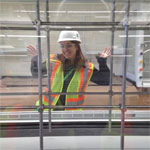
Ensure that your chemical fume hood sash is completely closed when not in use and at the end of every day.
In Discovery Teaching Labs, the chemical fume hoods have glass sides and a rear wall so that Teaching Assistants (TAs) can see what students are doing at all times.
To prevent fire from spreading through chemical fume hood ductwork, there are smoke detectors in the fume hood ducts. These are designed to shut down the building ventilation and set off the fire alarms so that occupants clear the building immediately. Burlington Fire Dept and UVM Police Services is immediately alerted when the building fire alarms sounds. These detectors can be triggered by fume or fog as well.
Airflow Monitors/Alarm
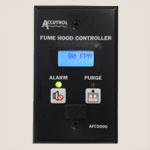 *The airflow for safe operations in STEM Discovery fume hoods are set to be 80 lfpm. Always move the sash slowly up or down so as not to disturb the airlfow or draw hazardous vapors out of the fume hood.
*The airflow for safe operations in STEM Discovery fume hoods are set to be 80 lfpm. Always move the sash slowly up or down so as not to disturb the airlfow or draw hazardous vapors out of the fume hood.
The fume hoods are able to be held open completely - ONLY when setting something up in the hood or for cleaning purposes. If the fume hood sash is left in the full open position too long, the fume hood alarm will go off. Remember, leaving a fume hood sash open also wastes energy.
The user has a limited amount of time to finish what they are doing before the alarm will appear on a Physical Plant control screen. *Muting the alarm will not make the notification disappear.* Always lower the sash when you are done putting equipment into or taking equipment out of the chemical fume hood.
The MAX height to use the fume hood safely is set at 18 inches. Use the fume hood with the sash at 18 inches OR LOWER!
When you lower the sash, the airflow in the hood will re-set to a safe and set amount. If the alarm continues to go off, Physical Plant personnel will respond to see what is happening.
*Click image to enlarge.
Chemical Fume Hood Purge Buttons
These are located on the fume hood monitor. If there is a chemical spill or strong odor in the hood or lab, the purge button will increase airflow inside the hood to exhaust more air out of the hood and the lab.
Shut the Sash Program
Fume hoods are one of the most energy intensive types of equipment in a laboratory. Significant energy savings can be achieved by keeping them closed when not in use.
Natural Gas Use
Blue Natural Gas Knob on Teaching Lab Benches
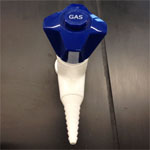 To operate, you must push down THEN turn knob to turn on.
To operate, you must push down THEN turn knob to turn on.
After using natural gas in a teaching lab, make sure to check the individual spigots to make sure the gas has been turned off completely.
Point-of-Use Regulators
These are used to regulate natural gas to proper psi at "point of use" in lab. DO not purchase your own point of use regulator.
Place a Famis Work Order through your administrative assistant to have one installed by Physical Plant personnel.
Red Emergency Power Off (EPO) Button
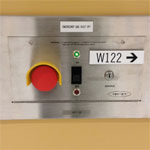 All of the emergency power off (EPO) buttons are located in hallway on a panel near the lab doors. EPO buttons only shuts off the natural gas to a particular lab as needed during an emergency.
All of the emergency power off (EPO) buttons are located in hallway on a panel near the lab doors. EPO buttons only shuts off the natural gas to a particular lab as needed during an emergency.
To use the EPO, simply hit the big red button. In order for the natural gas to be turned on again, Physical Plant must reset it at the panel.
If you want to make sure your lab will have natural gas, check the panel. If the green light is the only light lit up, natural gas should be flowing to your lab.
There are two areas in Discovery that one lab's panel is directly above the neighboring lab's panel. The green tape denotes which is which: green tape on the left part of the panel is for the lab to the left, green tape on the right part of the panel is for the lab to the right.
Compressed Nitrogen Gas Plumbed into Labs
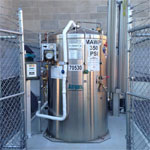 Compressed nitrogen gas is supplied to labs in Discovery from an Aigas bulk tank on the north side of the building. The pressure to individual labs is set by the valve from the bulk tank. Point-of-use regulators are able to further regulate the pressure. These are used to regulate the pressure to the proper psi (pounds per square inch) at "point of use" in the lab.
Compressed nitrogen gas is supplied to labs in Discovery from an Aigas bulk tank on the north side of the building. The pressure to individual labs is set by the valve from the bulk tank. Point-of-use regulators are able to further regulate the pressure. These are used to regulate the pressure to the proper psi (pounds per square inch) at "point of use" in the lab.
**Do NOT purchase or install your own point-of-use regulator.**
Place a Famis Work Order through your administrative assistant to have one installed by Physical Plant personnel.
House Vacuum System
Information coming soon!
GF Signet Flow Monitor
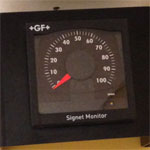 These monitors are found above some lab doors in the hallways. These measure the conductivity of the RO (reverse osmosis) water.
These monitors are found above some lab doors in the hallways. These measure the conductivity of the RO (reverse osmosis) water.
Fire Protection
Fire Doors
Every lab door in Discovery is a fire door and must be kept closed at all times. A door may be held open temporarily in order to bring large equipment into, or out of, the lab. Make sure to allow the door to close completely after the move is complete.
Magnetic Holders/Release
Some rooms have magnetic holders attached to the doors. This allows the door to be held open, and in the event of a fire or power outage, the door will automatically shut.
Stairwell Barricades
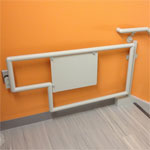 In the event of a fire, make sure to use the stairs to get to one of the two main exits (2nd floor, west side and 1st floor, north side). The stairwell to the basement (at the north end of the building) has a barricade that will release to block off the stairs. When coming up the stairs from the basement, the barricade swings out. When coming down the stairs from the first floor, the barricade will block the stairs to avoid anyone entering the basement accidentally. There is another barricade in the stairwell to the first floor at the south end of the building. This serves to avoid anyone going away from the exit available on the second floor.
In the event of a fire, make sure to use the stairs to get to one of the two main exits (2nd floor, west side and 1st floor, north side). The stairwell to the basement (at the north end of the building) has a barricade that will release to block off the stairs. When coming up the stairs from the basement, the barricade swings out. When coming down the stairs from the first floor, the barricade will block the stairs to avoid anyone entering the basement accidentally. There is another barricade in the stairwell to the first floor at the south end of the building. This serves to avoid anyone going away from the exit available on the second floor.
Fire/Emergency Strobes (wall-mounted and ceiling-mounted)
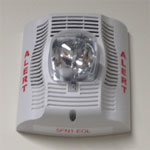 These strobes will flash and a recorded message will come over a loud speaker. Message will tell occupants to evacuate the building. It will also activate when there is a manual fire alarm pulled to notify occupants to evacuate the building.
These strobes will flash and a recorded message will come over a loud speaker. Message will tell occupants to evacuate the building. It will also activate when there is a manual fire alarm pulled to notify occupants to evacuate the building.
This is a critical fire alarm notification. LISTEN to the announcement and proceed accordingly. The message will most likely ask you to evacuate, but LISTEN to the message in case there are incident-specific instructions.
Emergency Lab Equipment
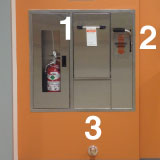 Emergency Stations in All Laboratories
Emergency Stations in All Laboratories
- Pull down on handle to activate eye wash
- Pull down on handle to activate safety shower
- Eye wash is designed to drain on the the lab floor. Do not worry about getting the floor wet - take care of your eyes, first and foremost.
Spill Response Center: in Chemistry TEACHING LABS only
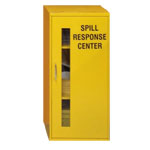 Inside of this Spill Response Center, you will find the following supplies:
Inside of this Spill Response Center, you will find the following supplies:
- Chemically inert spill pads - These are the same spill pads that are provided in spill kits. They can be used to soak up any small liquid chemical spills (< 1 L) in the lab. For spills greater than 1 L, call Service Operations Support (656-2560, ext. 1) to contact Risk Mgmt. and Safety to help with the cleanup.
- Sodium bicarbonate - This can be used to neutralize any acid spills.
- Dust pan and brush - There should be two sets of dust pans and brushes in each teaching lab, and one set should be located in the spill response center. They can be used together to clean up broken glass and solid materials.
- Zip-top baggies - Any debris generated while cleaning up a spill should be collected in a waste container. Collect all debris in the zip-top baggies, and tag as waste.
- Waste tags - Make sure to tag the lab's waste at the end of each teaching week, no later than Thursday night. Any waste that is generated during a spill cleanup must also be tagged for pickup.
If any of the materials in the spill response center are used, make sure they are re-stocked for the next TA. Again, any waste generated should be tagged for pickup.
Laser Labs
Obey Signage and Curtains
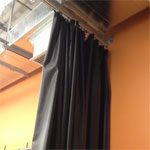 Laser labs – curtain
Laser labs – curtain
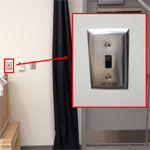 Laser labs - EPO
Laser labs - EPO
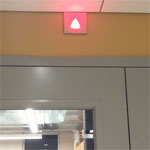 Laser labs – light in use
Laser labs – light in use
Building Hours: Occupied and Unoccupied
During "Occupied" hours (6am - 8pm) the building will be unlocked.
UNoccupied hours are from 8pm until 6am. Faculty, staff, and students will need to use CatCard panels to gain access to the building. Regardless if the building is in occupied or unoccupied mode, all interior doors should remain locked.
Communication Panels
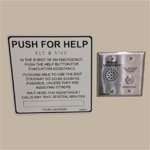 These communication panels ONLY supposed to be for people with mobility issues who cannot use the stairs during an evacuation, to wait there and call for help. These communication panels are located in STEM Discovery on the basement, 2nd, 3rd, and 4th floors by the south elevator. There is a panel located in the penthouse near the central elevator. NOTE: There is currently no communication panel on the 1st floor south elevator.
These communication panels ONLY supposed to be for people with mobility issues who cannot use the stairs during an evacuation, to wait there and call for help. These communication panels are located in STEM Discovery on the basement, 2nd, 3rd, and 4th floors by the south elevator. There is a panel located in the penthouse near the central elevator. NOTE: There is currently no communication panel on the 1st floor south elevator.
If you have mobility issues and were stranded and used it to call for help, the call will go to a panel next to the main fire alarm panel in the 2nd floor west (main) entry. Calls will only be answered if the Burlington Fire Department is already at the scene in the lobby at the main fire alarm panel.
Remember it is best to first call UVM Police at 802-656-FIRE (3473) if you need immediate assistance.
Emergency Generator Information
The emergency generator in Discovery buiding provides power to the following utilities:
- Building air handling systems (supply and exhaust),
- Fire detection and suppression systems,
- Emergency lighting,
- Elevators (return to ground floor),
- Red outlets,
- Plumbing drain systems (lab and domestic), and
- RO/DI water system (though this system may require resetting after a power transfer unless an uninterrupted power supply (UPS) is installed).
Emergency power is NOT supplied to central vacuum or compressed air systems (serving Discovery & Votey). The powered fan filters serving W006 (clean room) are not on the emergency power system, but there is still supply air serving this space. Even though supply and exhaust will be operational, if the electrical power becomes unreliable, lab operations should be stabilized and/or ceased as soon as possible.
The building nitrogen system will continue to operate during an electrical (power) outage.
Researchers should respond to loss of power in the building by stabilizing, ceasing, and making safe all hazardous operations and materials until restoration of main and backup power.
How does backup power work in Discovery?
A power transfer to the emergency generator takes about 10 seconds. It then takes about 5 minutes for all of the air handling fans to return to full operation. During this time there should be no depressurization issues in the building or labs, but the hoods will be in alarm until the fans return to their setpoint.
If your fume hood goes into alarm for any reason, close the sash as soon as possible. Loss of power does not automatically trigger a room or building evacuation provided the emergency generator responds and ventilation is restored.
Jeffords Hall
Storage Limit for Flammable Liquids
There is a 5-gallon limit on the storage of flammable liquids in each Jeffords building laboratory. This limit is based on fire code restrictions for a building of this type of construction.
For this reason, observing this limit is essential to the safety of all occupants and visitors. Always order flammable chemicals with this limit in mind.
Environmental Health & Safety can store extra flammable liquids that you may order if you have reached the limit in your lab. We discourage ordering cases of any chemical unless you are sure you will use the chemicals for your research within one year. Contact safety@uvm.edu with questions.
Emergency Power Backup
Red outlets have emergency power backup. These are often used for -80 or -20 freezers. For more information about refrigerator and freezer management, go to Laboratory Equipment Safety.
Concealed Sprinkler Heads
Sprinklers in Jeffords are recessed so the sprinkler head is not visible. Recessed sprinklers are an automatic fire protection system that can distribute water spray from fixed location. The frangible bulb breaks when a designated temperature is reached. This permits water to discharge.
Fire Extinguishers in Hallway
Fire Extinguisher doors in the hallways of Jeffords feel like they are locked. However, if you need to use the fire extinguisher, pull the door very hard to open it. UVM Life Safety staff can re-lock the door and refill the extinguisher after the emergency has passed. Have the department administrative assistant place a FAMIS Service Request to let them know you have activated a fire extinguisher.
Laboratory Gas Service Valve: Shuts off Natural Gas to Lab from the Hallway
A local alarm will sound if anyone tampers with tthe door of the Laboratory Gas Service Valve. Please do not tamper with these shutoff valves. Only Physical Plant personnel should turn on or shut off and tag out laboratory gas valves. Keep the door closed and secure when not in use.
Magnetic Holder/Release for Fire Doors
Some hallway and stairwell fire doors in Jeffords have a magnetic release. These doors are permitted to be opened and secured magnetically. Should an alarm sound, the doors are programmed to automatically release to prevent a fire from spreading. Never prop open a fire door that does not have an automatic release, such as indivdual laboratory doors.
Basement Level Barricade
You may notice a barricade in the stairwell as you head down to the basement level.
This barricade can be magnetically held open during regular business hours. However, it is programmed to automatically close if a fire alarm is sounding in the building. The barricade informs occupants who are evacuating a building that they have reached their exit destination and to not continue running down to the basement level where they may be trapped in a building fire.
Marsh Life Science
Chemical Fume Hood
Marsh Life Science has Variable Air Volume (VAV) hoods. This means that as the fume hood sash is lifted, an air velocity sensor within the fume hood detects the change in air velocity and the air control valves modulate. This allows the air velocity to be maintained at 100 feet per minute (fpm) at the face of the fume hood.
Each fume hood also has a face velocity sensor with an alarm to monitor the velocity of air passing through the fume hood. This alarm sounds when a face velocity of less than 100 fpm is detected. Never "mute" or tape your fume hood alarm button. If the alarm sounds irregularly, please call 802-656-2560, option #1 to have the hood alarm looked at or repaired.
Light Switch
Some fume hood air velocity alarms are interlocked with the lab's light on/off switch. In these labs, an alarm will signal if the fume hood sash is left open and the room lights are turned off to remind you to close the sash. Closing the sash saves energy as well.
Patrick Leahy Building (formerly the Hills Science Building)
NO Loading Dock/Deliveries
Hills building does not have a loading dock. The closest loading dock is Health Sciences Research Facility (HSRF) loading dock which comes into HSRF and Firestone labs on the 2nd floor. If you take an immediate left upon entering the hallway, you can go through a connector that leads to Stafford building. Stafford Building connects to Hills. Delivery drivers must be made aware of this constraint and perhaps given directions on how to deliver lab supplies or equipment, especially large lab equipment, into lab spaces.
Delivery drivers must also know that they will be unable to get to the 3rd floor to deliver items because the elevator to the 3rd floor is CatCard access only. Arrangements can be made in advance if delivery is needed to the third floor.
Intruder Locks
Some of the laboratories in Hills have intruder locks. If you push the interior button on the lock and leave the lab, the lab door WILL NOT LOCK. You must lock the door with a key to securely close it.
If you are IN the lab, and you press the button on the door lock, it will lock others out. It is designed to allow the occupant to lock themselves in if there is an intruder or shooter in the hallway. Occupants must be trained to use their intruder locks.
3rd Floor Secure
The third floor of Hills has CatCard access only.
Elevator
The elevator to the 3rd floor of Hills is CatCard acces only.
Perkins and Votey
Votey
Sprinklers
Votey Hall is a fully sprinklered building since summer of 2017. All fire and life safety features in the building have been upgraded.
Votey Lab Ventilation
Most Votey laboratories are designed so that lab air flows into the lab and maintains a slight negative pressure to the hallway.
This means lab doors should be kept closed at all times so the ventilation systems can work properly. Please do not prop lab doors open unless you are moving a cart or equipment in and out of the space; promptly close lab doors afterward. Lab ventilation is typically 6-8 air changes per hour (ACH).
Office spaces and some teaching labs have air that re-circulates to other parts of the building. NO chemicals or gases should be used in these areas. Email safety@uvm.edu if you do not know what type of ventilation your area has.
Please contact Environmental Health & Safety before you plan to conduct research in your lab using chemicals or any activity that could cause, and thus recirculate, odors.
Votey: Labs Have Different Types and Designs of Chemical Fume Hoods
There are different Chemical Fume Hood types in Votey labs. Most are "constant volume" fume hoods; this means they exhaust the same amount of air at all times, regardless of the hood's (glass) sash height.
Some labs have a fume hood with a vertical sash; others have a horizontal sash. At this time, chemical fume hoods in the Biomedical Teaching Lab (Votey 225) and in Votey 227 have what is called a "combination sash". In these labs, the glass sash can be used as one vertical rising sash or as a horizontally-sliding sash. Ensure you are trained to use your fume hood sash correctly. To safely work inside of a fume hood with multiple vertical glass sash panels, you must work with the glass sash in front of you with your arms around the glass. Never work in a fume hood without glass sash protection in front of you.
Some Votey fume hoods have an on/off switch. Ensure you know whether your fume hood is constamntly running or if you have to turn it on before you begin working.
Fume Hood Airflow Monitors
Chemical fume hood monitors provide a readout of hood airflow. Some of Votey fume hood monitors will read 550-700 cfm. Other hoods in Votey will read 80-120 lfpm. Get trained to know what your fume hood should read and check this readout before you start working in the fume hood.
A tell tail should be taped on every fume hood so the user can visually see if the air is flowing into the hood or not. If there is no air flowing into the fume hood or if the airflow appears to be coming out of the fume hood based on the direction of the tell tail, contact 802-656-2560, option 1 immediately. Do not use the fume hood unless the tell tail is flowing INTO the hood.
Purge Button on Fume Hood Monitor
Some fume hood monitors in Votey have a "purge" button. Pushing this button does nothing. These particular fume hoods are already moving the maximum amount of air into the fume hood so pushing the "Purge" button will NOT increase airflow inside of the hood.
Votey Protoype Shop/Machine Shop
Votey houses a large metal machine shop where students learn to design and make prototypes. Students who want to use the Prototype Shop must complete ME81. The Votey Prototype Shop lab air is positive to the hallway. The Shop also has its own individual fume extraction system for welding activities.
Emergency Strobe Lights
Votey has new emergency strobe lights installed in all hallways as of summer 2017. The strobe light will warn hearing impaired individuals that an emergency is in progress and to leave the building immediately.
Lab Door Locks
Several new (2017) lab door locks are "intruder locks". The door can be locked by someone from the inside of the lab by pushing a button on the lockset; this is intended to lock an intruder in the hallway or the building out of the room.
Pushing the intruder lock (inside) button will NOT local the lab. You must lock these labs with a key to ensure the door is locked.
Many labs in Votey are controlled by CatCard access. There is a CatCard reader to enter and the door automatically locks when you leave. Do NOT prop these doors open for extended periods of time.
Basement Level Barricades
You may notice a magnetic barricade in a few Votey stairwells as you head down to the basement level.
This barricade informs occupants, who may be evacuating the building, that they should exit and to not continue running down to the basement level where they may be trapped in a building fire. The barricade is programmed to automatically close if an alarm is sounding in the building.
Perkins Building Features
Perkins is an UNsprinklered historic wooden structure. There is NO fire suppression in Perkins. Know where the closest Exit is and be prepared to quickly LEAVE THE BUILDING if there is a fire or if a fire alarm is sounding.
Perkins Ventilation
Perkins has one laboratory (104A,B) with lab ventilation (8-12 air changes per hour). This lab also has 2 chemical fume hoods. The lab airflow is set up to be negative to the hallway. Keep the lab doors closed to maintain negative pressure.
NOTE: Never charge batteries in Perkins overnight or UNattended.
Soldering Rules for Votey or Perkins
Anyone who wishes to solder must complete Soldering Safety Training online. (See "Specific Hazards"). You must talk to Courtney GIles to access a table top fume extractor or use a soldering snorkle in the "FabLab", Room 246.. Never solder in any area of Votey or Perkins without using some form of task ventilation.
Stafford
Fume Hood Controls
There is a toggle switch on the wall of each lab (sometimes hidden behind appliances or other equipment) that regulates the airflow to each chemical fume hood. When the room is occupied, the toggle switch should be in the "occupied" position. To save energy, the last person leaving the lab should put the toggle switch back to the "unoccupied" position.
Each fume hood also has a face velocity sensor with an alarm. This sensor monitors the velocity of air passing through the fume hood and will alarm when an unsafe condition is detected. Please do not "mute" or tape over your fume hood alarm.
Terrill Hall
Emergency Purge Button
The lab emergency purge buttons were removed in 2022. They no longer provide a purge of lab air.
Fume hood monitors have a "purge" button and can provide a form of "purge" or increase in airfow inside of the fume hoods should a lab need to evacuate an odor swiftly.
Manual Fire Pull Alarm
Manual Fire Pull Alarms in Terrill are encased with a protective plastic cover. A local alarm will sound in Terrill when this cover is lifted; the local alarm is a "tamper" alarm to discourage students from foul play.
Be sure to pull the manual push/pull alarm handle in order to sound the building alarm during an emergency. This will notify other Terrill occupants of the emergency so they can evacuate safely.
Natural Gas Shutoff Lever
Terrill labs have an natural gas shutoff with a lever in each lab. The gas shutoff is encased in a protective plastic cover.
Only UVM Physical Plant personnel should touch this gas valve.
The gas shutoff valve is turned off and locked out when Physical Plant Dept personnel are conducting maintenance or repairs to the natural gas lines.
